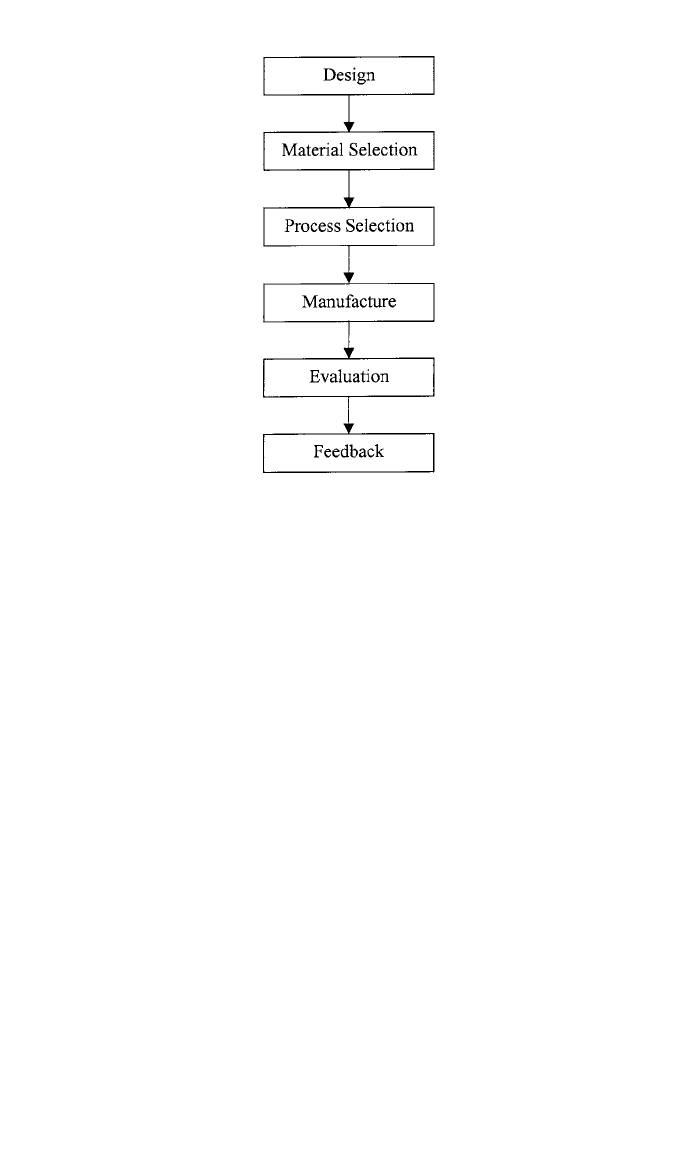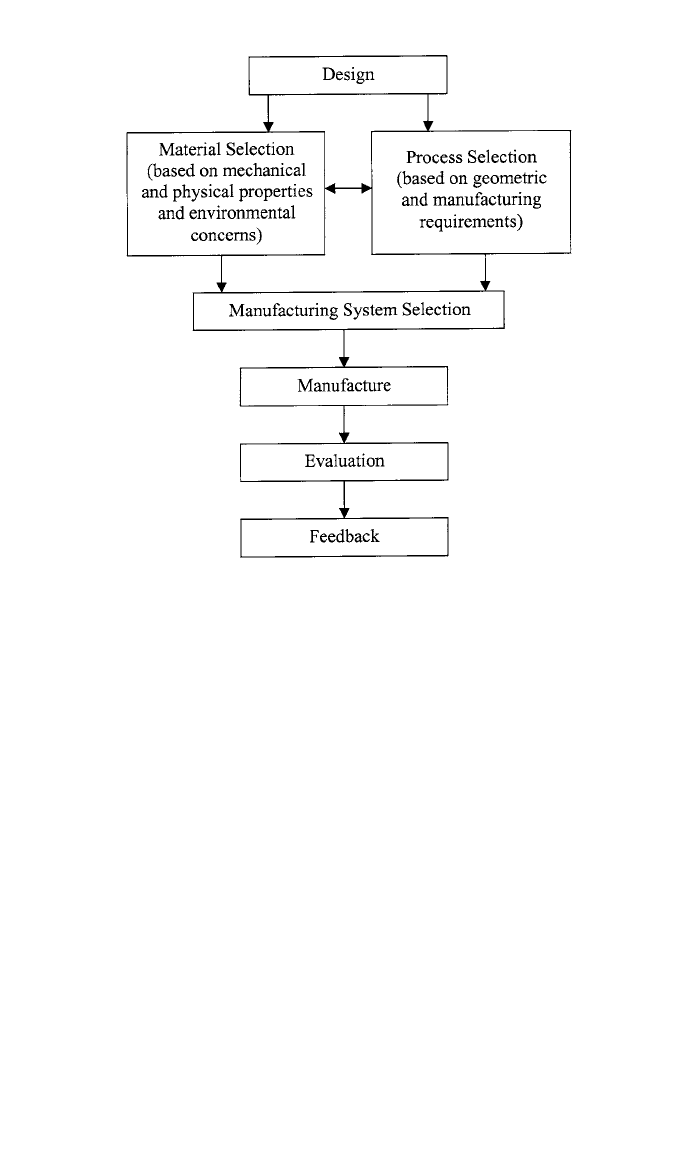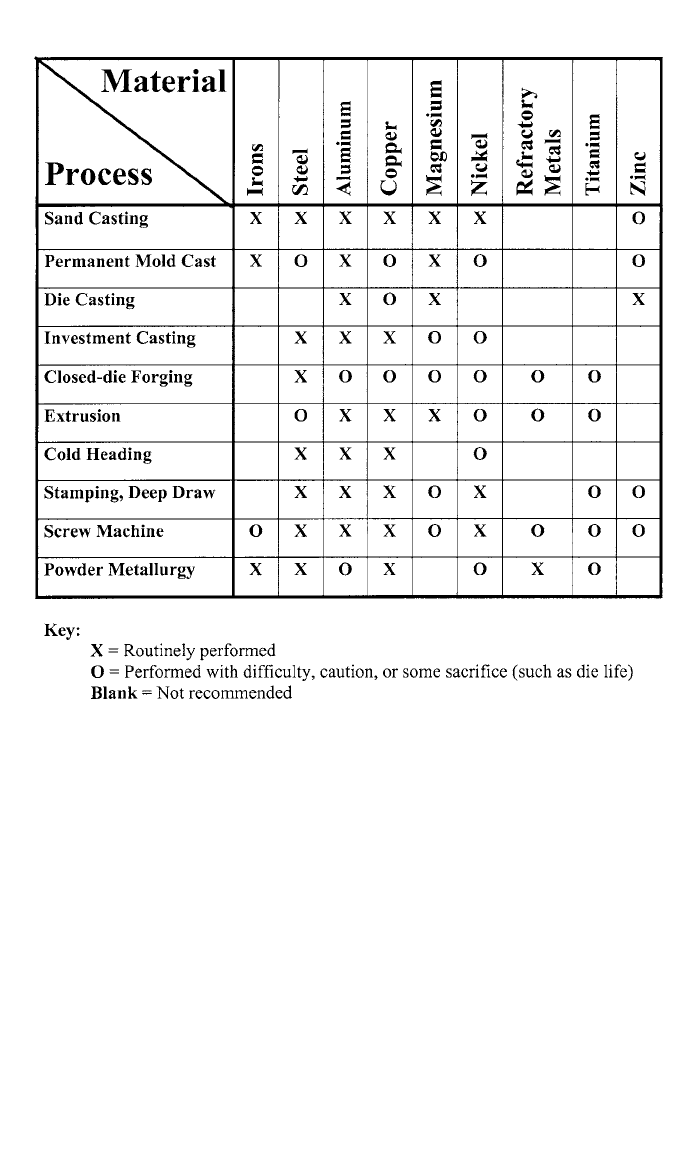Kutz M. Handbook of materials selection
Подождите немного. Документ загружается.


832 MATERIALS SELECTION, DESIGN, AND MANUFACTURING PROCESSES
Fig. 1 Typical sequence of manufacturing activity.
they feel would be the best purchase for a college student and then prepare a
brief justification of their recommendation. Invariably, some will find the two-
slice model to be adequate, while others favor the four-slice feature. Most would
select the thin-slot design, but a few would feel that thick bagels are a morning
necessity that must be accommodated. Invariably there will be a range of qual-
ities (good, better, and best) with companion increments in price. Are the more
expensive models clearly better and best? Is the additional cost increment jus-
tified to upgrade from good to better, or yet another additional amount to go for
best? Different students will select and defend different models. It is almost
impossible to get a group consensus in view of the multiple judgmental factors
that can be considered, and so it is with many of the decisions in manufacturing.
2 VARIOUS APPROACHES
There are several possible approaches that may be taken in the manufacture of
products or components. One of the simplest is the case history approach. By
accessing what has been done in the past (or done by a competitor), we can
learn from that experience, use it as a starting base, and either duplicate or
modify the details of that solution. A basic assumption of this approach is that
similar requirements can be met with similar solutions.
While it is true that similar products can often be made with similar materials
and processes, the real question is, How similar is similar? A minor variation in
a service requirement (such as operating temperature or corrosive environment)
may be sufficient to justify a totally different material or manufacturing method.
In addition, this approach often overlooks new materials, new technology, and
manufacturing advances that may have occurred since the formulation of the
original solution.

3 DESIGN 833
It is also quite possible that the exercise is driven by aspects of current pro-
duction. Evaluation of one of your products may have revealed some form of
deficiency. A major customer may have requested a product just like the one
you are currently making, but capable of operating at higher temperature, or in
an acidic environment, or at higher pressure. With access to all of the details of
the current part and its present method of manufacture, you must now determine
how the problem should be overcome or the additional requirement accommo-
dated.
The most comprehensive approach to part manufacture would be for an en-
tirely new product where there is no existing reference material or process. Here
the process begins by defining, in a very precise way, what it is that we want
to produce, how it will be used, what conditions it will see, and what properties
it must possess. The answers to these and related questions form a set of re-
quirements that will then enable the evaluation of candidate materials and com-
panion methods of fabrication. For completeness, it is this approach that will be
further developed.
3 DESIGN
The first step in any manufacturing problem is to define the needs of the product,
i.e., to describe the ‘‘target’’ in complete detail. The word design is often used
to describe this process and entails the specification of geometric requirements,
property requirements, and manufacturing requirements for each component of
the assembly. It is the responsibility of the designer to identify the specific
properties or characteristics that will be necessary for each part to adequately
perform its intended function.
A dimensioned sketch can begin to answer many of the questions about the
size, shape and complexity of each part. Additional details, however, are often
essential. How precise must the dimensions be? Are all dimensions precise or
only a certain fraction, and, if only a few, which ones? What are the surface
finish requirements? If all surfaces do not have the same requirements, which
ones are restrictive and what fraction do they comprise? Are there axes or planes
of symmetry? Does the part have a uniform cross section when viewed from a
certain direction? How does this component interact geometrically with the other
components?
While the above questions may be viewed as simply defining geometrical
needs, they will actually form the basis for subsequent decisions. At some point,
for example, we will have to determine how to manufacture the requested shape.
We know that die casting, for example, can be used for parts that range from
less than an ounce to more than 100 lb, but wall thicknesses should ideally be
less than -in. Permanent mold casting extends the wall thickness limit to 2
5
––
16
inches, and there is no limit at all for sand casting. At the same time, dimensional
precision and the as-cast surface finish becomes progressively worse as we move
from die casting to permanent mold casting to sand casting. Secondary opera-
tions, such as machining, grinding, or polishing, all involve the handling, posi-
tioning, and processing of individual parts and can form a significant portion of
the total manufacturing cost. Therefore, the objective is usually to ‘‘hit the tar-
get’’ with the least number of operations. Extrusion and rolling are metal forming

834 MATERIALS SELECTION, DESIGN, AND MANUFACTURING PROCESSES
processes that are known for their ability to produce long pieces of constant
cross section. Powder metallurgy products must have shapes that can be ejected
from a die. Thus, we may quickly have some specific processes in mind, and
may want to consult the designer if it appears that a possible geometric modi-
fication would significantly improve either the ease of manufacture or subsequent
performance of the part.
Getting the right shape is only part of the desired objective. If a part is to
perform adequately, it is imperative that it also possesses the necessary me-
chanical and physical properties, as well as the ability to endure the anticipated
environments for a desired period of time. Consideration and specification of
these properties is another aspect of component design.
Let us begin by considering some of the possible mechanical property re-
quirements. Will the part need a certain level of static strength? If it is acciden-
tally overloaded, is it permissible to have a sudden brittle failure or is
deformation or distortion a desirable precursor to fracture? How much can the
component bend or deflect under load and still function properly? Are impact
loadings expected? If so, what will be the type, magnitude, and velocity? Are
vibrations or cyclic loadings anticipated? Will they be uniform or varying? What
is the anticipated frequency and magnitude? Is wear resistance desired? Where
and how deep? Will all of the above requirements be necessary over the entire
range of operating temperatures?
Not all of the requirements will be mechanical. Some may be electrical, mag-
netic, thermal, or optical. These physical property requirements must also be
considered. Must the component be an electrical insulator or conductor? Are
any magnetic properties desirable? Is there a need for thermal conductivity? If
temperature will change during operation, must thermal expansion or contraction
be restricted or matched to other components? Are there any optical require-
ments? Is weight a factor? What about overall appearance or the availability in
specified or varied colors?
Another area of consideration involves the interaction of the component with
its operating environment, that is, environmental concerns. What are the lowest,
highest, and normal operating temperatures? How fast might temperature
change? Are the temperature changes cyclic or varied? Are all of the above
properties required over the entire range of temperatures? What is the most
severe operating environment from the perspective of corrosion or deterioration
of material properties? What is the desired lifetime of the product? Should it be
manufactured for ease of repair, disposal, or recycling? What is the potential
liability if the product should fail?
The above considerations are only a sample of the many questions that must
be addressed when precisely defining what it is that we want to produce. Col-
lectively, they will serve to direct and restrict the selection of engineering ma-
terial. It is possible that the requirements will be such that several families of
materials, and numerous members of those families, will all be adequate, and
selection becomes a matter of preference. It is also possible that one or more of
the requirements will emerge as a dominant restriction (such as the need for
ultrahigh strength, superior wear resistance, the ability to function at high op-
erating temperatures, or the ability to withstand extremely corrosive environ-

3 DESIGN 835
ments), and selection becomes focused on those materials offering that unique
characteristic.
Help in identifying candidate materials or families of materials may be found
by classifying the various requirements as ‘‘absolute’’ or ‘‘compromisable.’’ Ab-
solute requirements are ones that must be met or the part will fail. Materials
that fall short of absolute requirements are automatically eliminated. Compro-
misable properties are those that might differentiate good, better, and best, where
all would be deemed adequate. These requirements are helpful in prioritizing
materials where more than one candidate emerges.
Still another family of factors remains to be specified. We might call these
manufacturing concerns because they will ultimately be used to help select an
economical manufacturing process or processes. Foremost among these factors
might be the number of identical parts to be produced and the desired rate of
production or anticipated rate of consumption. One-of-a-kind parts are rarely
made by processes that require dedicated patterns, molds, or dies. The expense
of dedicated tooling is too hard to justify for a production run of one. Instead,
flexible processes, such as machining, are likely to be used where the skill of
an operator generates the unique details of the part. Processes that only produce
one part an hour may be quite adequate for aerospace assembly where the pro-
duction rate is only several planes per month. In contrast, processes that require
more than several seconds per part may be unattractive for automotive compo-
nents that will be used on high-volume models.
Additional manufacturing concerns include the desired level of quality (com-
pared to similar products on the market) and the related quality control and
inspection requirements. It may be necessary, for example, to provide inspection
access to specific surfaces or locations on a product, and this requirement would
need to be addressed as the manufacturing process and sequence of activities is
formulated. Assembly (or disassembly) concerns and key relationships between
mating parts also need to be noted.
As we progress through the design stage, it is important to define the entire
spectrum of needs. The focus should be on the various ‘‘requirements,’’ and we
should avoid jumping to ‘‘solutions.’’ Nevertheless, the need or desirability for
certain manufacturing processes may become blatantly obvious. If this is so, we
might also want to note the desirability for material characteristics such as en-
hanced machinability, weldability, formability, castability, or hardenability.
Time spent in defining the specific needs or requirements of a product is
indeed time well spent. It will enable reasonable decisions to be made, and will
help to prevent costly errors or product failures that might result from some
form of oversight.
Figure 1 depicted a series of activities moving from design to material selec-
tion and then to process selection. Figure 2 shows a modified form of Fig. 1
where the material selection and process selection activities are now parallel and
not sequential. This figure reflects the fact that it is not uncommon for one of
these two selections to assume a dominant role and the other to become sec-
ondary or dependent. For example, the production of a large quantity of a small,
intricate part with thin walls, precise dimensions, and smooth surfaces may be
an ideal candidate for die casting. If this process is clearly the most attractive

836 MATERIALS SELECTION, DESIGN, AND MANUFACTURING PROCESSES
Fig. 2 Modified sequence of manufacturing activity showing parallel selection
of material and process.
means of manufacture, material selection may be restricted to die-castable ma-
terials—assuming feasible alternatives exist. In a converse example, highly re-
strictive material properties, such as the ability to endure extreme elevated
temperatures or severe corrosive environments, may significantly limit the ma-
terial options. The fabrication options will be focused on those that are com-
patible with the candidate material. Figure 3 schematically presents some of the
commonly accepted material—process compatibilities and incompatibilities.
4 MATERIAL SELECTION
A wide spectrum of engineering materials is currently available, each with its
own unique set of strengths and limitations. It is possible that one material will
emerge as the obvious choice for meeting the design requirements. More likely,
there will be multiple candidates that will each meet the requirements to varying
degrees. Selection now becomes a matter of preference with the final choice
reflecting the relative merits of the entire manufacturing systems (material and
complete method of fabrication). It may also be possible that no existing material
is capable of meeting the stated requirements, or the materials that are feasible
are eliminated because of features such as high cost, limited availability, envi-
ronmental concerns, or the need for recyclability. In these cases, alternatives
must be made possible through redesign, compromise of requirements, or the
development of new engineering materials.

5 SELECTION OF FABRICATION PROCESS 837
Fig. 3 Commonly accepted material-process compatibilities.
It should also be noted that it is not uncommon to have to make decisions
with incomplete information. Not all of the desired data may be available, or
the data may be for test conditions that differ somewhat from those anticipated
for the part in question. This is yet another example of where educated judgment
is required.
5 SELECTION OF FABRICATION PROCESS
Our objective is to produce parts with the right shape and companion properties
that will enable successful performance of the intended function. We must now
consider the various ways of producing the desired shape and evaluate each with
regard to its compatibility with the candidate materials.
The possibilities here are numerous. Material removal processes start with an
oversized piece of material and then remove some so as to leave the desired
shape. All of the traditional machining processes are included here: turning,
drilling, milling, boring, and others. Also included in this category are grinding,
electrodischarge machining (EDM), electrochemical machining (ECM), waterjet
cutting, and other nontraditional processes.

838 MATERIALS SELECTION, DESIGN, AND MANUFACTURING PROCESSES
A number of casting processes have been developed based on the premise
that a liquid assumes the shape of its container. By producing shaped molds,
and solidifying the material in the mold, a wide variety of extremely complex
shapes can be produced in an equally wide range of sizes.
Deformation processes exploit the plasticity of engineering materials, utilizing
applied forces to induce movement or flow. Rolling, extrusion, forging, wire
drawing, sheet metal forming, and other processes can be used to mass produce
parts from ductile materials.
An equally diverse group of processes can be used to produce shapes by
joining smaller pieces together. These consolidation processes include welding,
brazing, soldering, industrial adhesives, mechanical fasteners, and powder met-
allurgy.
Selection of one or more candidate processes begins with an evaluation of
the previously discussed geometric requirements and manufacturing concerns.
Key geometric features include size, shape, complexity, and symmetry, as well
as the desired dimensional precision and surface finish. Dominant manufacturing
concerns include the desired quantity and rate of production.
With a clear picture of the requirements and desires, we can begin to evaluate
the alternatives. Each of the manufacturing processes has distinct advantages and
limitations, and these can often form the basis for a prescreening. Further re-
finement can be based on a number of considerations. Is the process compatible
with candidate materials? Is the size of the part, including features such as wall
thickness, consistent with process capabilities? If the process is used, how pre-
cise will the final dimensions be? What is the expected surface finish? Does the
process take advantage of any product symmetries or other geometrical features?
What is the form of the required starting material and are there any associated
economies that should be noted? Will the process require special tooling (such
as molds, dies, fixtures, etc.) that will be unique to the desired part, and can the
cost be justified?
For each of the possible materials, one or more compatible processes (or
series of processes) should be identified, resulting in candidate manufacturing
systems. At this stage, each system consists of a material and companion fab-
rication process. By comparing their relative merits, it is hoped that we can
clearly identify a ‘‘best’’ alternative.
6 COMPLETING THE SYSTEM: SECONDARY PROCESSING
It is rare for a single manufacturing process to produce a part with both the
desired shape and the desired properties. One process may produce the desired
dimensional precision in a single operation, while another less expensive alter-
native might require some secondary machining. Grinding or polishing may be
necessary to produce surfaces with the desired surface finish. These secondary
processes must be incorporated into each of the candidate manufacturing sys-
tems. Moreover, because these secondary processes incur the added expenses of
handling, positioning, fixturing, and associated tooling, it is not uncommon for
them to be among the most expensive stages of the system.

7 SELECTION OF ‘‘BEST’’ SYSTEM 839
In addition to meeting the geometric requirements, we must also assure the
necessary properties. While each of the candidate materials was selected for its
ability to possess the desired properties, these properties may not be present
when the part emerges from the shape-producing process. Secondary processing
may be required to induce property modification. Heat treatments, for example,
can significantly alter the mechanical properties of engineering metals and other
materials. Surface treatments can provide enhanced wear resistance, enhanced
corrosion resistance, or the appearance features that will promote sales and mar-
ketability.
7 SELECTION OF ‘‘BEST’’ SYSTEM
We began with well-defined needs and objectives and proceeded to identify
candidate manufacturing systems, each of which begins with a starting material
and includes everything that must be done to convert it into the desired final
product. Every one of the options involves a series of highly interrelated deci-
sions. Performance and property needs restrict candidate materials. Various ma-
terials limit the fabrication possibilities. The fabrication method, in turn, affects
the material properties. Processes designed to modify certain properties may
simultaneously alter other properties.
Selection of the best alternative requires a complete understanding of all of
the various restrictions and interrelations incorporated in each candidate system.
In addition to a performance evaluation, consideration should also be given to
the costs associated with both material and processing, environmental safety,
recycling or reclamation of both the end product and processing wastes, mini-
mization of required energy, and aspects of process control, quality control of
the product, and product liability.
Because of the need to maintain multiple perspectives and incorporate diverse
expertise, it is not uncommon for manufacturing decisions to be made by a team
of individuals. Representation from the design function is essential to assure that
each of the various requirements is met and that any adjustment in those re-
quirements is acceptable. Materials specialists bring expertise in candidate ma-
terials, their structure and properties, and the effects of various processing.
Manufacturing personnel know about the capabilities of various processes, as
well as the equipment available and the cost of associated tooling. Quality and
environmental specialists bring their perspective and expertise. Failure analysis
personnel can provide valuable experience gained from their examination of
unsuccessful efforts. Customer representatives or marketing specialists may also
be consulted for their opinions. Clear and open communication is vital to the
making of sound decisions and compromises.
The design and manufacture of a successful product is an iterative and evolv-
ing process. Costs change, prototype or customer assessment may reveal unex-
pected weaknesses or the possibility of improvements, and manufacturing
problems may be encountered. A change in material may well require a change
in manufacturing process, and conversely improvements in processing may war-
rant a reevaluation of material. It is vitally important to maintain an understand-
ing of the various system interactions to assure that any change or corrective
action will not adversely affect other aspects of the system.

840 MATERIALS SELECTION, DESIGN, AND MANUFACTURING PROCESSES
8 INTERRELATIONSHIP EXAMPLES
To illustrate some of the many interrelationships between design requirements,
engineering materials, and manufacturing processes, let us now consider a series
of examples:
Example 1: Products Made from Crystalline Ceramics
Crystalline ceramic materials are ionic or covalently bonded and therefore ex-
hibit a characteristic brittleness. The absence of ductility makes the plastic de-
formation processes unavailable to these materials. High bond strengths impart
the characteristic of high melting points. Casting processes require the handling
of molten materials, and the high melting temperatures present considerable
problems. In addition, nonuniform cooling from high temperatures can generate
high residual stresses, often sufficient to induce fracture in the product. As a
result, casting processes are generally not considered for the crystalline ceramics.
For similar reasons, joining processes that involve molten material, such as fu-
sion welding, are likewise eliminated. Mechanical fasteners lead to concentrated
stresses and again the likelihood of brittle fracture. Therefore, joining is largely
limited to adhesive or diffusion bonding. Many of the material removal processes
involve some form of mechanical cutting action, and this also would result in
fracture of ceramic materials. Material removal, therefore, is usually restricted
to grinding, polishing, or chemical etching. Having eliminated a large number
of fabrication processes as being incompatible with ceramic materials, we find
that the production of a desired shape is often limited to processes that bond
together a multitude of small particles, i.e., particulate processing. The design
and manufacture of ceramic products, therefore, is frequently restricted by the
limitations of particulate processing.
Example 2: Classroom Chalk Tray
As another example of the interrelation between design, materials, and process-
ing, consider the common classroom chalk tray. The requirements here are not
very restrictive. Depending upon design, the chalk tray may be required to sup-
port the static weight of the writing board, and most will sometime encounter
the leaning weight of a tired or casual instructor. Otherwise, the demands are
quite minimal. Wood has been a longtime standard for this application and usu-
ally employs adhesive bonding to produce the necessary lengths, coupled with
some form of machining operation designed to produce the long, continuous
cross-section products. Some negative concerns are the role of grain and knots
in fracture and splintering, as well as the need to provide periodic maintenance
in the form of surface refinishing. As a competing material, aluminum sections
offer light weight, enhanced durability, and low maintenance. Since aluminum
is highly ductile, the extrusion process can be used to produce the desired cross
section in the necessary lengths. Extruded thermoplastic polymers offer yet an-
other competitive system with lower strength and durability, but also lower cost.
Example 3: Household Window Frames
The continuous-cross-section components of a household window frame bear
considerable similarity to our classroom chalk tray, but bring some additional
requirements. The appearance of both external and internal surfaces is quite

8 INTERRELATIONSHIP EXAMPLES 841
important, as well as the desire for low maintenance. Since the pieces provide
a continuous transition from interior to exterior, thermal conductivity (i.e., in-
sulating ability) is yet another concern. Wood sections are quite attractive and
can utilize a wide spectrum of finishes and coatings. As with the chalk tray,
however, there are concerns relating to grain, knots, and the required periodic
maintenance of repainting or refinishing. The possibilities of swelling, shrinking,
and warping are additional concerns for the window application. Aluminum has
all of the advantages described with the chalk tray, plus the ability to be inex-
pensively finished through color anodizing to produce a range of desirable colors
and textures. The high thermal conductivity is a distinct disadvantage that may
lead to sweating or condensation in winter, but this may be overcome through
a design that incorporates some form of thermal barrier. Extruded vinyl will
probably meet all of the mechanical requirements. The attractive feature of in-
tegral color (obtained by incorporating dyes or pigments with the resin) elimi-
nates the need for both internal and external finishing operations. Dimensional
instability over time, low-temperature brittleness, and the deteriorating effects of
ultraviolet light are some of the negative concerns.
A survey of building supply warehouses or actual homes will reveal that each
of the above materials currently commands a segment of the market. There is
no clear-cut winner, and selection becomes largely a matter of pros, cons, and
preferences.
Example 4: Bamboo
Material science education has long recognized the interrelation between struc-
ture and properties, and this relationship forms a major portion of most intro-
ductory courses. As an example of such a relationship, consider the natural
material known as bamboo. Bamboo is a long, segmented, tubular material com-
posed of longitudinal fibers bonded by a weaker lignin matrix. Longitudinal
fractures are somewhat easy to form in this material, since they require only the
rupture of the weaker lignin to separate the parallel fibers. Transverse fracture,
however, requires rupture of the stronger fibers. Moreover, since the fibers are
independent of one another, the fracture does not propagate continuously. In-
stead, each fiber must break individually, producing the characteristic ragged
fracture. A transverse fracture, therefore, requires far more energy than a lon-
gitudinal one. Now let us extrapolate this observation to a far more critical
application.
Example 5: Aerospace Turbine Blades
The individual turbine blades used in the exhaust regions of jet engines must
withstand high temperatures, high stresses, and highly corrosive operating con-
ditions. Because of the life-threatening consequences, failure by fracture is to-
tally unacceptable.
The extremely demanding operating requirements severely limit the material
possibilities, and most jet engine turbine blades have been fabricated from one
of the high-temperature superalloy metals. Fabrication processes are limited to
those that are compatible with both the material and the desired geometry.
Through the 1960s and into the early 1970s, investment casting was the standard
method of fabrication. This resulted in a polycrystalline product with thousands
